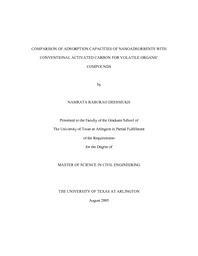| dc.contributor.author | Deshmukh, Namrata Baburao | en_US |
| dc.date.accessioned | 2007-08-23T01:56:37Z | |
| dc.date.available | 2007-08-23T01:56:37Z | |
| dc.date.issued | 2007-08-23T01:56:37Z | |
| dc.date.submitted | August 2005 | en_US |
| dc.identifier.other | DISS-1035 | en_US |
| dc.identifier.uri | http://hdl.handle.net/10106/398 | |
| dc.description.abstract | This research explores the potential for using single wall carbon nanohorns (SWNHs) for adsorption of volatile organic compounds (VOCs) categorized as hazardous air pollutants and which contribute to ground level ozone smog formation. It also compares the adsorption capacity of conventional activated carbon and carbon nanohorns.
Carbon nanoadsorbents, with at least one dimension on the nanometer scale, can possess advantages over traditional activated carbon adsorbents in terms of binding energies or interaction potentials for physisorption. Nanotubes and nanohorns both have excellent adsorption properties due to high-energy adsorption sites in their interior (internal pores) and in the region between adjacent nanotubes/nanohorns (interstitial channel). Nanohorns would be preferable for air pollutant removal applications because they self-assemble into spherical aggregates, with space between adjacent nanohorns large enough to accommodate small gas molecules and also are cheaper to manufacture as compared to nanotubes.
This research aims at:
1. Determining the adsorption capacity of open-end carbon nanohorns with heat treatment and densification and closed-end carbon nanohorns, with and without heat treatment and densification, for a variety of VOCs (alkanes and alkenes);
2. To determine which type of adsorbent gives the maximum adsorption capacity for a majority of the VOCs, and whether there are any trends in adsorption capacity vs. compound structure;
3. To determine the adsorption capacity of regular activated carbon for the same VOCs;
The experimental setup consisted of a gas chromatograph, gas tight syringes, 4mL clear glass vials with rubber septae and Tedlar bags. The compounds to be tested included alkenes; ethylene and propylene and alkanes; butane and hexane. The adsorbents used were closed-end nanohorns without any treatment, closed-end nanohorns with treatment (densification), open-end nanohorns with treatment (densification) and activated carbon pellets. Calibration curves were first created for each of the compounds on the GC software. Trial and error runs were conducted to determine the approximate minimum weight of nanohorns required for reasonably good adsorption, minimum time required for equilibrium and the maximum volume of compound that can be adsorbed by each type of adsorbent for each combination of compound and adsorbent.
The vials were filled with the minimum weight of adsorbent, which was found to be 0.03g, and a known volume of gas was shot in them. After the equilibrium time had passed, the same volume was drawn out of the vial and injected into the GC to determine the residual concentration of gas in the vial after adsorption. Similar runs were conducted for each combination of gas and adsorbent with increments varying from 1mL to 10mL in volume. Adsorption isotherms were plotted with the residual concentrations in ppm obtained from the GC on X-axis and mass of volatile organic compound adsorbed per unit mass of adsorbent used in grams/grams. | en_US |
| dc.description.sponsorship | Sattler, Melanie L. | en_US |
| dc.language.iso | EN | en_US |
| dc.publisher | Civil & Environmental Engineering | en_US |
| dc.title | Comparison Of Adsorption Capacities Of Nanoadsorbents With Conventional Activated Carbon For Volatile Organic Compounds | en_US |
| dc.type | M.S.C.E. | en_US |
| dc.contributor.committeeChair | Sattler, Melanie L. | en_US |
| dc.degree.department | Civil & Environmental Engineering | en_US |
| dc.degree.discipline | Civil & Environmental Engineering | en_US |
| dc.degree.grantor | University of Texas at Arlington | en_US |
| dc.degree.level | masters | en_US |
| dc.degree.name | M.S.C.E. | en_US |
| dc.identifier.externalLink | https://www.uta.edu/ra/real/editprofile.php?onlyview=1&pid=972 | |
| dc.identifier.externalLinkDescription | Link to Research Profiles | |

